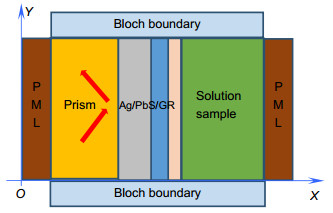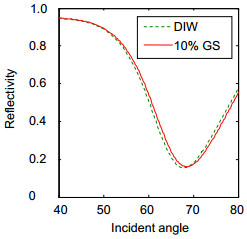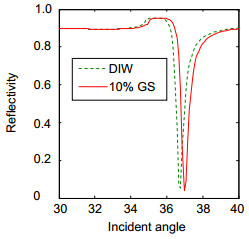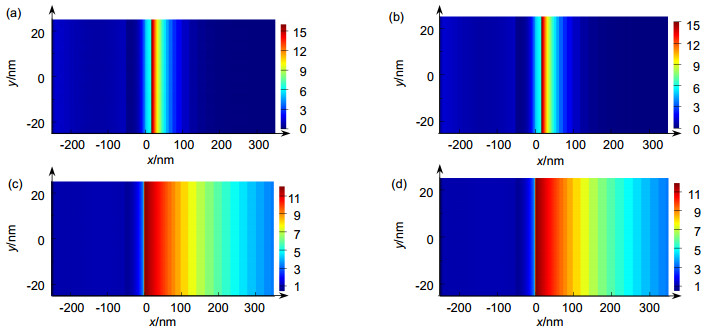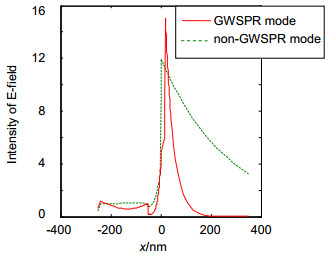High sensitivity SPR sensor for Liquid phase sample with Ag/PbS/Graphene hybrid nanostructure
-
Abstract:
A surface plasmon resonance (SPR) sensor with Ag/PbS/GR hybrid nanostructure has been proposed for the diagnostics of liquid phase samples. Here Ag/PbS/GR hybrid nanostructure is designed as an asymmetric MIM waveguide for surface plasmon. Due to the guided wave SPR (GWSPR) modes, the index of the liquid phase samples can be measured more accurately than the conventional SPR sensors. Numerical simulation results show that the sensitivity of the sensor is about 5 times higher than the conventional SPR sensors. The origin of the enhancement mechanism is the combination of GWSPR in the Ag/PbS/GR hybrid nanostructure which enables the surface plasmon to spread along the PbS layer. In Ag/PbS/GR hybrid nanostructure, the electric field is concentrated mostly in the PbS layer, and the enhancement of the field intensity is nearly 30%.

-
Key words:
- surface plasmon resonance /
- surface plasmon waveguide /
- SPR sensor /
- sensitivity
-

Abstract: Sensors based on surface plasmon resonance (SPR) are widely recognized as valuable tools for sensing of liquid phase samples. It can be used in real-time monitoring of various biomolecular interactions, such as DNA hybridization and protein bindings since it is a simple, direct, real time and sensitive optical sensing technique used for probing refractive index changes. In recent years, Graphene (GR) has been applied in SPR sensors to improve the sensitivity. However, the detection sensitivity and accuracy of the sensors are lower for the loss of the electromagnetic field in GR which leads to the damping field and broad resonance peak in the SPR curve.
Here, a surface plasmon resonance (SPR) sensor with Ag/PbS/GR hybrid nanostructure has been proposed for liquid phase samples. The Ag/PbS/GR hybrid nanostructure is designed as an asymmetric MIM waveguide for surface plasmon. Due to the guided wave SPR (GWSPR) modes, the index of the liquid phase samples can be measured more accurately than the conventional SPR sensor. We use two sample solutions (DI water and 10% glucose solution) to test properties of the sensors. Numerical results show that the sensitivity of the sensor is about 5 times higher than the conventional SPR sensor. The origin of the enhancement mechanism is the combination of GWSPR in the Ag/PbS/GR hybrid nano-structure which enables the surface plasmons to spread along the PbS layer. Corresponding to the GWSPR mode, in Ag/PbS/GR hybrid nano-structure, the electric field is concentrated mostly in the PbS layer at 50 nm~70 nm, just like a MIM waveguide. The counterpart to the sensor with only Ag nano-membrane is from 0 nm to 100 nm. Because most of the field is now in the dielectric layer, which is less absorptive than metal, it is expected that the surface plasmon propagates a longer distance along the surface thus increasing the sensitivity. In addition, the maximum of the E-field intensity is increased by 30% in the MIM wavegudie which leads to the higher interactivity between the surface plasmons and samples.
-

-
[1] Chung J W, Kim S D, Bernhardt R, et al. Application of SPR biosensor for medical diagnostics of human hepatitis B virus (hHBV)[J]. Sensors and Actuators B: Chemical, 2005, 111–112: 416–422. doi: 10.1016/j.snb.2005.03.055
[2] Riedel T, Rodriguez-Emmenegger C, de los Santos Pereira A, et al. Diagnosis of epstein-barr virus infection in clinical serum samples by an SPR biosensor assay[J]. Biosensors and Bioelectronics, 2014, 55: 278–284. doi: 10.1016/j.bios.2013.12.011
[3] Williams C, Addona T A. The integration of SPR biosensors with mass spectrometry: possible applications for proteome analysis[J]. Trends in Biotechnology, 2000, 18(2): 45–48. doi: 10.1016/S0167-7799(99)01389-X
[4] Hossain M B, Rana M M. Graphene coated high sensitive surface plasmon resonance biosensor for sensing DNA hybridization[J]. Sensor Letters, 2015, 14(2): 145–152. http://www.academia.edu/11521463/Md._B._Hossain_Md._M._Rana_Graphene_coated_high_sensitive_Surface_plasmon_resonance_biosensors_for_sensing_DNA_hybridization_Sensor_Lett._Vol._14_no._2_pp.-145-152_Feb._2016_Indexed_by_Scopus_ERA_Rank_C_Impact_Fac._0.687_
[5] Homola J, Yee S S, Gauglitz G. Surface plasmon resonance sensors: review[J]. Sensors and Actuators B: Chemical, 1999, 54(1–2): 3–15. doi: 10.1016/S0925-4005(98)00321-9
[6] Hutter E, Fendler J. Exploitation of localized surface plasmon resonance[J]. Advanced Materials, 2004, 16(19): 1685–1706. doi: 10.1002/(ISSN)1521-4095
[7] Sharma A K, Jha R, Gupta B D. Fiber-optic sensors based on surface plasmon resonance: a comprehensive review[J]. IEEE Sensors Journal, 2007, 7(8): 1118–1129. doi: 10.1109/JSEN.2007.897946
[8] Maharana P K, Jha R, Palei S. Sensitivity enhancement by air mediated graphene multilayer based surface plasmon resonance biosensor for near infrared[J]. Sensors and Actuators B: Chemical, 2014, 190: 494–501. doi: 10.1016/j.snb.2013.08.089
[9] Zeng Shuwen, Hu Siyi, Xia Jing, et al. Graphene–MoS2 hybrid nanostructures enhanced surface plasmon resonance biosensors[J]. Sensors and Actuators B: Chemical, 2015, 207: 801–810. doi: 10.1016/j.snb.2014.10.124
[10] Meshginqalam B, Toloue H, Ahmadi M T, et al. Graphene embedded surface plasmon resonance based sensor prediction model[J]. Optical and Quantum Electronics, 2016, 48: 328. doi: 10.1007/s11082-016-0597-8
[11] Pu Mingbo, Yao Na, Hu Chenggang, et al. Directional coupler and nonlinear Mach-Zehnder interferometer based on metal-insulator-metal plasmonic waveguide[J]. Optics Express, 2010, 18(20): 21030–21037. doi: 10.1364/OE.18.021030
[12] Sekkat Z, Hayashi S, Nesterenko D V, et al. Plasmonic coupled modes in metal-dielectric multilayer structures: Fano resonance and giant field enhancement[J]. Optics Express, 2016, 24(18): 20080–20088. doi: 10.1364/OE.24.020080
[13] Kretschmann E. The determination of the optical constants of metals by excitation of surface plasmons[J]. Zeitschrift Für Physik A Hadrons and Nuclei, 1971, 241(4): 313–324. doi: 10.1007/BF01395428
[14] Maier S A. Plasmonics: fundamentals and applications[M]. New York, US: Springer, 2007.
[15] Lahav A, Auslender M, Abdulhalim I. Sensitivity enhancement of guided-wave surface-plasmon resonance sensors[J]. Optics Letters, 2008, 33(21): 2539–2541. doi: 10.1364/OL.33.002539
[16] Chandran A, Barnard E S, White J S, et al. Metal-dielectric-metal surface plasmon-polariton resonators[J]. Physical Review B, 2012, 85(8): 085416. doi: 10.1103/PhysRevB.85.085416
[17] Mrabti A, Lévêque G, Akjouj A, et al. Elastoplasmonic interaction in metal-insulator-metal localized surface plasmon systems[J]. Physical Review B, 2016, 94(7): 075405. doi: 10.1103/PhysRevB.94.075405
[18] Taflove A, Hagness S C. Finite-difference time-domain solutions of Maxwell's equations[M]. Webster J G. Wiley Encyclopedia of Electrical and Electronics Engineering. New York: John Wiley & Sons, Inc., 2016.
-


 E-mail Alert
E-mail Alert RSS
RSS

 下载:
下载:
